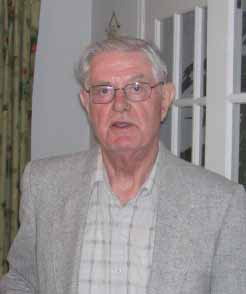Peter Egelstaff was a scientist well-known within the neutron scattering community and beyond for his infectious enthusiasm for his subject. Wherever he went he left a cloud of stimulating ideas, not always sound but always thought-provoking. Coming into the field after the award of a PhD at London University in 1954, he was a pioneer in the use of neutron scattering to study condensed matter. His seminal and on-going work, in the design and construction of instruments, taking measurements and providing theoretical interpretations of data and not least in his persistence in getting his ideas put into practise, made an unequalled contribution to the field of neutron beam research as we know it today, particularly in its application to understanding the liquid state.
Peter's career in neutron scattering started when he joined the AERE Harwell in 1954. His work was driven by the technological need to provide data to estimate temperature coefficients of reactivity of fuel and moderator in the designs of the first generation of commercial nuclear power stations in the UK. A major four-pronged programme had been launched in support of this aim: foil measurements by Campbell at AEEW at Winfrith Heath in Dorset, measurements of thermal neutron energy spectra by Poole using an electron linac, the Scattering Law Project under Egelstaff designed to produce data to enable the calculation of thermal end epithermal energy distributions in reactors. At the same time, this subject of neutron thermalisation was becoming important in other areas, such as the Steam Generating Heavy Water Reactor, then a contender for UK power generation and the design of a cold neutron source for the new materials testing reactor DIDO (1957) under Heinz London and John Webb also with input from Egelstaff. The 1962 paper On the Evaluation of the Thermal Neutron Scattering Law by Egelstaff and Schofield soon became a citation classic.
After a spell at AECL, Chalk River in Canada, building a chopper spectrometer, Peter returned to Harwell, while continuing to supervise there his active group of Harwell scientists. He was given the task of interesting university scientists in the use of instruments being commissioned on the new research reactors DIDO and PLUTO (1958), As many have testified, he was immensely successful at this, particularly among chemists, Julia Higgins in polymers, John White, Alan Leadbetter, physical chemistry, and Tom Waddington, inorganic chemistry. In physics one of his most successful collaborations was with John Enderby in determining the structure of liquid metals and alloys by using the isotope substitution technique in diffraction work, which is still widely used some 50 years later. For many, a first encounter with Peter proved, literally, a life-changing experience. The use by university scientists was soon formalised in the AERE – SRC Joint Programme which ran until newer and more powerful sources became available with eventually the closure of Harwell's reactors. Towards the end of the sixties Peter was a leading light in the new field of Laser Doppler Anemometry (LDA), being pioneered by a large collaboration between AERE (involving George Benedek on sabbatical), Oxford University, RRE (Malvern), again seminal work leading to a major part of the case for today's powerful light sources. Using a Mössbauer source he was involved in a test of Einstein's theory of gravitation.
In 1970 Egelstaff, frustrated by personality clashes with the management blocking his proposals, left Harwell (having been refused five years leave of absence!) to become Chair of the Department of Physics at the University of Guelph, newly formed from an existing agricultural college. Here he continued neutron work at Chalk River and at Guelph developing supercomputer programmes to simulate liquid state properties; he was a member of the consortium which obtained NSERC funding for the first array processor in Canada suitable for simulations. He created by his enthusiasm a new North American community of visitors, postdoctoral fellows and graduate students
Peter Egelstaff had a formidable list of publications. He edited the compilation Thermal Neutron Scattering (1965) and in 1967 published the influential An Introduction to the Liquid State. He was elected a Fellow of the Royal Society of Canada in 1980. He was named the Researcher of Distinction for the first twenty-five year historical period of the University of Guelph. After his retirement in 1990 he was awarded an Honorary Doctor of Science from the University of Waterloo and University Professor Emeritus at Guelph.

